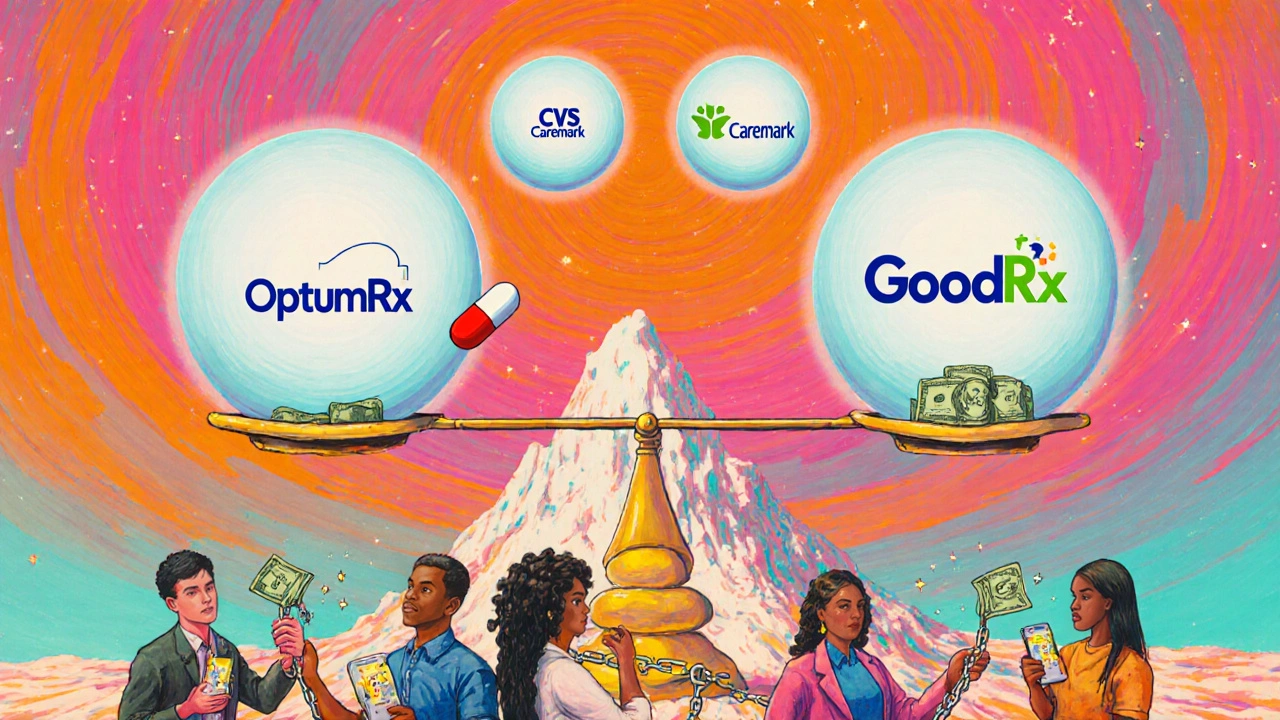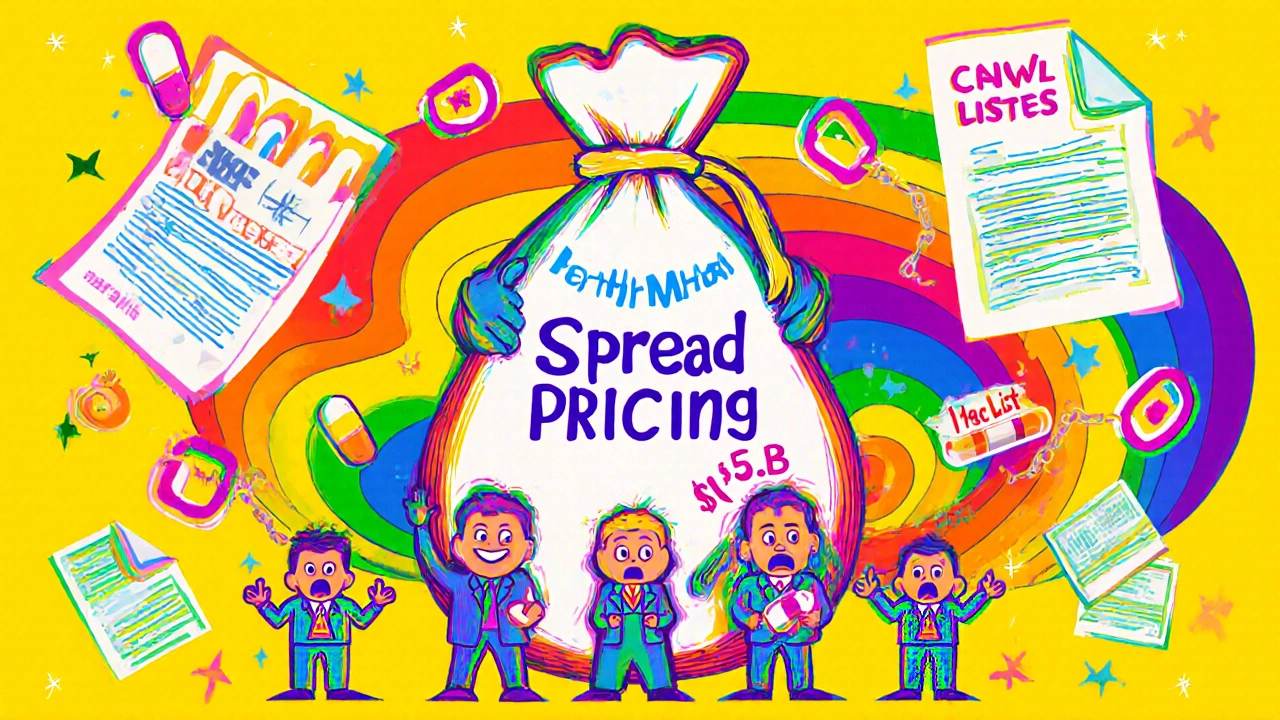Most people assume their insurance saves them money on generic drugs. But if you’ve ever been shocked by a $45 copay for a $4 pill, you’re not alone. The system behind generic drug pricing isn’t broken-it’s designed this way. And it’s not the drugmakers or pharmacies setting the price. It’s the middlemen: Pharmacy Benefit Managers, or PBMs.
Who Really Controls Generic Drug Prices?
PBMs don’t sell drugs. They don’t run pharmacies. But they control what you pay at the counter. Three companies-OptumRx, CVS Caremark, and Express Scripts-handle about 80% of all prescription claims in the U.S. They negotiate with drug manufacturers, set reimbursement rates for pharmacies, and decide which generics are covered under your plan. Their contracts are secret. Their pricing formulas are hidden. And the way they make money often has nothing to do with lowering your costs.Here’s how it works: PBMs create a Maximum Allowable Cost (MAC) list for every generic drug. This is the most they’ll pay a pharmacy to fill your prescription. But here’s the catch: the MAC isn’t based on what the pharmacy actually paid for the drug. It’s based on a formula using outdated benchmarks like Average Wholesale Price (AWP) or National Average Drug Acquisition Cost (NADAC). These numbers are often inflated, outdated, or manipulated.
The Hidden Profit: Spread Pricing
The biggest secret in generic drug pricing is called spread pricing. PBMs charge your insurer (or your employer’s plan) one price for a drug-say, $15 for a 30-day supply of metformin. Then they reimburse the pharmacy only $5. The $10 difference? That’s profit. And it’s not disclosed to you, your doctor, or even your pharmacist in most cases.That’s why you sometimes pay more with insurance than without. If you walk into a pharmacy and pay cash, you might get the same metformin for $4. But if you use your insurance, you pay $12 because your plan’s MAC is set at $15, and your copay is 80% of that. The pharmacy gets $5. The PBM pockets $10. You pay $12. No one wins except the middleman.
A 2023 Wall Street Journal investigation found patients paying out-of-pocket for cancer and multiple sclerosis generics often paid less than those using insurance. In one case, a patient paid $45 for a generic through insurance-but only $4 if they paid cash. The PBM didn’t lower the price. It just shifted the cost to the patient.
Why Don’t Pharmacies Tell You?
Pharmacists know. They see the cash price on their screen. They know you’re being overcharged. But 92% of PBM contracts include gag clauses-legal restrictions that prevent pharmacists from telling you about lower cash prices. These clauses were so common that Congress banned them in 2020 under the No Surprises Act. But enforcement is weak. Many pharmacies still don’t speak up, fearing retaliation from PBMs who control their reimbursement rates.Independent pharmacies are especially vulnerable. A 2024 report from the National Community Pharmacists Association found that 11,300 independent pharmacies closed between 2018 and 2023. Why? Because PBMs keep lowering reimbursement rates while increasing administrative burdens. Pharmacies now spend 200-300 hours a year just decoding PBM contracts. Some hire specialists at $100,000 a year just to keep up.

Clawbacks and Broken Promises
Even after you pay your copay, the story isn’t over. PBMs often do something called clawbacks. After processing your claim, they go back and demand money from the pharmacy if the reimbursement rate was too high. That means a pharmacy might get paid $5 for a drug, only to be billed $2 later because the PBM changed the MAC list without notice.That’s not rare. In 2023, the FTC reported that 63% of independent pharmacies had been hit with clawbacks. Some pharmacies lose thousands a year because of these retroactive adjustments. And there’s no appeal process. No transparency. Just a letter from a PBM saying, “We’re taking back $3.78.”
What About Copays? They Haven’t Changed in 25 Years
You might think copays have gone up with inflation. They haven’t. In 1999, the average copay for a formulary generic was $5.17. In 2024, it’s $5.25. That’s it. No increase. But the cost of running a pharmacy has soared. Rent, staff wages, software, compliance-all up. So how do pharmacies survive? They rely on volume. And PBMs control volume.That’s why your plan might cover 10 generic versions of a drug-but only one is “preferred.” That’s the one the PBM gets the biggest rebate on. So even if your drug is covered, you might be steered toward a version you’ve never heard of, because it’s cheaper for the PBM-not because it’s better for you.

The Bigger Picture: .2 Billion in Hidden Profits
PBMs made $15.2 billion in 2024 from spread pricing alone-and 68% of that came from generic drugs. That’s more than the entire annual budget of the CDC. And it’s all hidden inside your insurance plan. You don’t see it on your bill. Your employer doesn’t see it. Even your insurer often doesn’t know the full amount.Meanwhile, generic drugs make up 90% of all prescriptions but only 23% of total drug spending. That’s because the system isn’t designed to lower costs-it’s designed to shift them. The higher the list price, the bigger the rebate the PBM gets from manufacturers. And guess what? That rebate often comes from your out-of-pocket costs.
Dr. Joseph Dieleman of the Institute for Health Metrics and Evaluation put it bluntly: “The current PBM system creates perverse incentives where higher list prices generate larger rebates, ultimately increasing patient cost-sharing burdens.”
What’s Changing? And When?
There’s pressure building. In September 2024, the Biden administration issued an executive order banning spread pricing in federal programs like Medicare and Medicaid-starting January 2026. Forty-two states are now passing laws requiring PBM transparency. Some require PBMs to disclose MAC lists. Others ban gag clauses outright.The Inflation Reduction Act’s Medicare drug price negotiation program is also starting to ripple into the private market. If Medicare can negotiate lower prices for 20 drugs in 2025, PBMs will have to adjust their models. Stanford researchers estimate this could save $200-250 billion over ten years-if it expands to commercial plans.
But the industry isn’t going quietly. PhRMA, the drug lobby, argues that PBMs are essential for innovation. But the data doesn’t support that. Generic drug manufacturers don’t need rebates to stay in business. They make money on volume. The real beneficiaries are the PBMs.
What Can You Do?
You can’t change the system alone. But you can stop being a passive participant.- Always ask the pharmacist: “What’s the cash price?”
- Use apps like GoodRx or SingleCare to compare prices before you fill a prescription.
- If your copay is higher than the cash price, pay cash. Your insurance won’t count it toward your deductible-but you’ll save money now.
- Ask your employer to demand PBM transparency in your health plan. Push for plans that pass through 100% of rebates to the plan sponsor.
The truth is simple: generic drugs aren’t expensive. The system that sells them is. And until that system changes, you’ll keep paying more than you should.


Tom Shepherd
November 27, 2025 AT 02:12just paid $12 for metformin with insurance. cash was $3.79. why do i even have this plan?
Jauregui Goudy
November 27, 2025 AT 04:19this is the most infuriating thing i’ve ever read. i thought my insurance was helping me. turns out it’s just a middleman scam where i pay more, the pharmacy gets screwed, and the PBM laughs all the way to the bank. someone needs to burn this whole system down.
marie HUREL
November 28, 2025 AT 20:26i’ve been using GoodRx for years. never realized how much i was overpaying until i compared prices. now i always check cash vs insurance. it’s wild how the system is rigged. i feel bad for small pharmacies-they’re stuck between a rock and a hard place.
Rebecca Price
November 28, 2025 AT 20:28let me get this straight: we’re punishing patients and small businesses to enrich a handful of corporate middlemen who don’t even make the drugs? this isn’t capitalism-it’s feudalism with a pharmacy receipt.
shawn monroe
November 30, 2025 AT 04:37the MAC list manipulation + spread pricing + clawbacks = triple-layered extraction model. PBMs are essentially rent-seekers operating under the guise of cost containment. the FTC should’ve broken them up in 2018. now we’re looking at systemic market failure in Rx logistics.
Frances Melendez
December 2, 2025 AT 04:09people who use insurance for $4 pills are just being irresponsible. if you can’t afford $4, don’t take the drug. stop blaming the system-you’re the problem.
Jonah Thunderbolt
December 2, 2025 AT 10:38OMG this is literally the most evil thing I’ve ever seen 😭💔 PBMs are the Voldemort of healthcare-no one talks about them but they control everything. I’m starting a petition. #BreakUpPBMs #CashIsKing 🚨💸
Emma Dovener
December 3, 2025 AT 20:15my sister works at a small pharmacy in Ohio. she told me they spend 3 days a month just decoding PBM contracts. sometimes they get clawed back $200 a week. they’re not making a profit-they’re surviving on goodwill and caffeine.
Sue Haskett
December 4, 2025 AT 21:15Wait-so you’re saying I’ve been paying $15 for a $5 drug for years? And my pharmacist knew? And couldn’t tell me? That’s not just unethical-that’s illegal! And yet, nothing’s changed. I feel like I’ve been gaslit by my own healthcare plan.
Jebari Lewis
December 5, 2025 AT 18:22the structural incentives are perverse: higher list prices = bigger rebates = more profit for PBMs. this is not a market failure-it’s a market design failure. the solution isn’t better regulation-it’s structural disintermediation. eliminate spread pricing, mandate full transparency, and pass-through rebates directly to plan sponsors. otherwise, we’re just rearranging deck chairs on the Titanic.
the fact that copays haven’t changed since 1999 while operating costs have skyrocketed proves this isn’t about affordability-it’s about extraction. the system was built to maximize PBM margins, not minimize patient burden. and until we treat PBMs like the oligopolistic gatekeepers they are, nothing will change.
the Biden executive order is a start, but it’s too narrow. we need federal legislation that applies to commercial insurance too. otherwise, you’re just moving the problem from Medicare to Blue Cross.
in the meantime, patients must become price-savvy consumers. use GoodRx. ask for cash prices. refuse to pay inflated copays. demand transparency from employers. the only leverage we have is our wallets-and we’re not using them.
the real tragedy? the generic drug supply chain is efficient, scalable, and low-cost. the only thing bloated is the administrative layer. remove the PBMs, and the cost collapses. we don’t need more bureaucracy-we need less.
the data is clear: 90% of prescriptions are generics. 90%. yet they’re being used as profit engines. this isn’t innovation. it’s exploitation. and it’s been going on for decades under the radar.
the fact that 11,300 independent pharmacies closed since 2018? that’s not market consolidation. that’s corporate violence. PBMs don’t just control pricing-they control survival. and they’re choosing who lives and who dies.
if you think this doesn’t affect you, you’re wrong. you’re not just a patient. you’re a consumer. and your money is being siphoned into a black box with no accountability. the time for passive acceptance is over.
Lauren Zableckis
December 5, 2025 AT 20:42i just started using SingleCare. saved me $28 on my thyroid med. wish i’d known sooner. thanks for sharing this.
archana das
December 6, 2025 AT 20:37in india, generics are sold for pennies at local shops. no insurance needed. no middlemen. no secrets. just medicine. i wonder if the world forgot that drugs are meant to heal, not to profit.
Asha Jijen
December 7, 2025 AT 08:06so basically the system is rigged and we’re all dumb for not knowing? wow. guess i’ll just keep paying $45 for a $4 pill then. lol